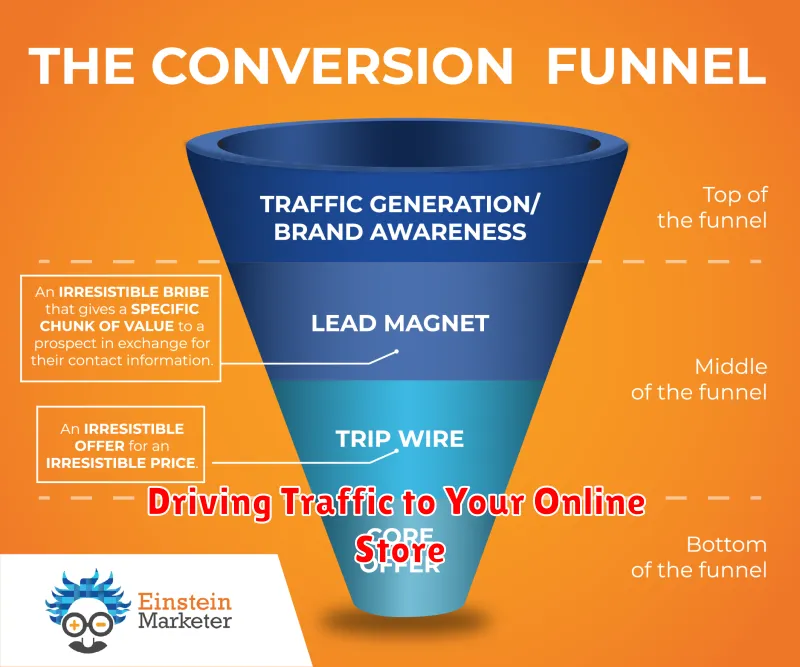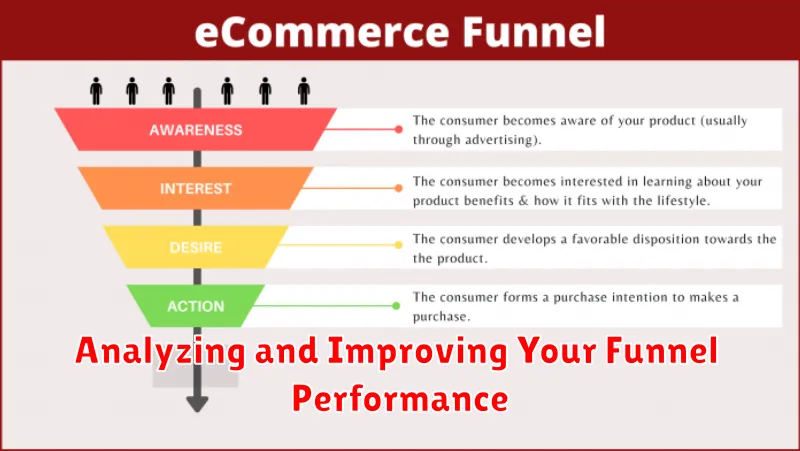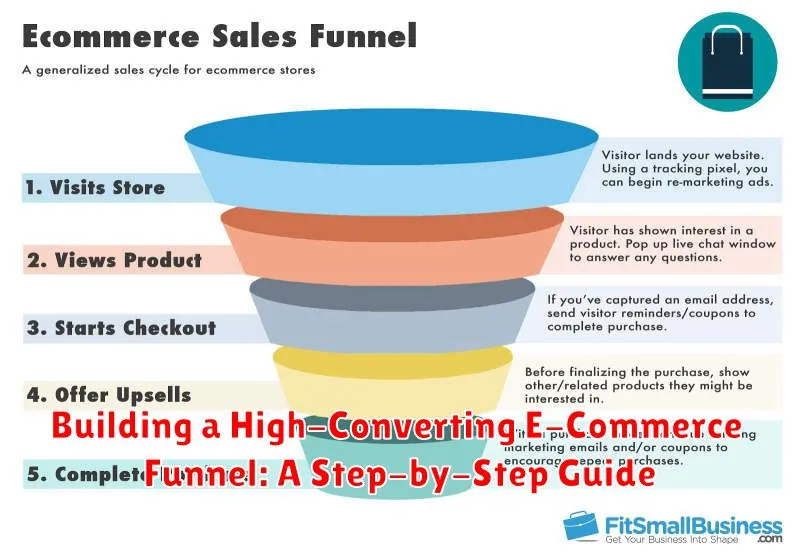Are you struggling to convert your e-commerce website visitors into paying customers? Do you want to maximize your sales and boost your revenue? This comprehensive, step-by-step guide will teach you how to build a high-converting e-commerce funnel that effectively guides potential customers through the buyer’s journey, from initial awareness to final purchase. Learn how to optimize each stage of your e-commerce sales funnel for maximum impact, using proven strategies and practical tips. We will cover everything from attracting targeted traffic to nurturing leads, recovering abandoned carts, and ultimately, driving conversions and building customer loyalty.
Building a successful e-commerce funnel is crucial for any online business seeking sustainable growth. This guide breaks down the complex process into manageable steps, offering actionable insights on crafting compelling offers, designing persuasive landing pages, implementing effective email marketing campaigns, and leveraging the power of social media. Whether you’re a seasoned e-commerce entrepreneur or just starting out, this guide provides the knowledge and tools you need to create a high-performing e-commerce funnel that consistently delivers results. Master the art of converting visitors into loyal customers and unlock the true potential of your online store.
Understanding the E-Commerce Sales Funnel
The e-commerce sales funnel is a visual representation of the customer journey, from initial awareness of your brand to a completed purchase. It illustrates the various stages a potential customer goes through before becoming a paying customer.
Think of it as a funnel, where a large number of potential customers enter at the top, and a smaller, more qualified group emerges at the bottom as buyers. Each stage of the funnel represents a different level of customer engagement, requiring tailored marketing strategies to nudge them further down the path to conversion.
By understanding this funnel, businesses can identify areas for improvement, optimize their marketing efforts, and ultimately increase their sales. It helps pinpoint where potential customers are dropping off and address any obstacles hindering their progress.
Key Stages of a Typical E-Commerce Funnel
A typical e-commerce funnel can be broken down into several key stages, each representing a crucial step in the customer journey towards a purchase. Understanding these stages allows you to optimize each touchpoint for maximum conversions.
Awareness: This is the first stage where potential customers become aware of your brand and products. They might discover you through search engines, social media, or advertising.
Interest: Once aware, customers may start showing interest in your offerings. They might visit your website, browse product pages, or read reviews.
Desire: At this stage, the customer develops a desire for your product. Compelling product descriptions, high-quality images, and positive reviews can fuel this desire.
Action: This is the final stage where the customer takes action by adding the product to their cart and completing the purchase. A smooth checkout process and secure payment options are crucial here.
Analyzing Your Target Audience and Their Needs
Understanding your target audience is crucial for building a successful e-commerce funnel. Analyzing their needs, preferences, and online behavior allows you to tailor your marketing efforts and optimize each stage of the funnel for conversions.
Start by defining your ideal customer profile. Consider demographics like age, gender, location, income, and education level. Dive deeper into psychographics, including their interests, values, lifestyle, and pain points.
Market research plays a vital role in this process. Utilize online surveys, conduct interviews, and analyze competitor data to gain insights into your target audience’s needs and desires.
Understanding their online behavior is equally important. Analyze which platforms they frequent, what type of content they engage with, and how they interact with brands online. This information helps you strategically position your products and messaging to resonate with them.
Crafting a Compelling Value Proposition
A compelling value proposition clearly communicates the unique benefits customers receive by choosing your products or services over the competition. It answers the crucial question: “Why should I buy from you?” A strong value proposition is essential for converting prospects into paying customers.
Identify your key differentiators. What makes your business stand out? Do you offer superior quality, faster shipping, personalized service, or exclusive products? Pinpoint the aspects that give you a competitive edge.
Focus on customer benefits. Don’t just list features; explain how those features benefit the customer. For example, instead of stating “organic cotton sheets,” emphasize the benefit: “Experience luxurious comfort and a healthier sleep with our organic cotton sheets.”
Keep it concise and clear. Your value proposition should be easily understood at a glance. Use simple language and avoid jargon. A confused customer is less likely to convert.
Test and refine. Continuously analyze the effectiveness of your value proposition. A/B test different versions to see which resonates best with your target audience. Monitor your conversion rates and make adjustments as needed.
Driving Traffic to Your Online Store

Attracting a steady stream of visitors is crucial for e-commerce success. A multi-faceted approach leveraging various channels is often the most effective strategy.
Search Engine Optimization (SEO)
Organic search traffic is invaluable. Implement a robust SEO strategy, focusing on relevant keywords, high-quality content, and technical optimization to improve your search engine rankings.
Paid Advertising
Consider utilizing paid advertising platforms like Google Ads and social media advertising to reach a wider audience. Targeted campaigns can effectively drive traffic to specific product pages.
Social Media Marketing
Establish a strong social media presence. Engage with your target audience, share valuable content, and run promotions to drive traffic to your store.
Email Marketing
Build an email list and leverage email marketing campaigns to promote new products, special offers, and valuable content, encouraging repeat visits.
Nurturing Leads Through Targeted Content and Offers
Once you’ve captured a lead, the next crucial step is nurturing them towards a purchase. This involves providing valuable content and offers tailored to their interests and stage in the buying journey.
Segmentation is key. Divide your leads based on their behavior, demographics, or purchase history. This allows you to personalize your messaging and offers for maximum impact.
Email marketing remains a powerful tool for lead nurturing. Automated email sequences can deliver targeted content, product recommendations, and special promotions.
Consider offering lead magnets such as exclusive discounts, free shipping, or downloadable resources in exchange for email sign-ups. This provides immediate value and encourages further engagement.
Retargeting campaigns can re-engage website visitors who showed interest but didn’t make a purchase. Displaying relevant ads on social media or other websites keeps your brand top-of-mind.
Optimizing the Checkout Process for Conversions
A streamlined checkout is crucial for converting potential customers into paying ones. A complicated or lengthy process can lead to cart abandonment and lost revenue. This section focuses on key optimizations for a smooth and efficient checkout experience.
Minimize Required Fields
Only ask for essential information. Reduce the number of form fields to the absolute minimum required to process the order and shipment. Every extra field adds friction.
Offer Guest Checkout
Forcing account creation can deter first-time buyers. Provide a guest checkout option to allow quick and easy purchases. Offer account creation after the purchase is complete.
Provide Multiple Payment Options
Supporting various payment methods caters to a wider audience. Include popular choices like credit cards, debit cards, PayPal, and digital wallets like Apple Pay and Google Pay.
Clearly Display Security Information
Build trust by displaying security badges and SSL certificates. Customers need to feel confident that their information is safe.
Building Customer Loyalty Post-Purchase
Cultivating customer loyalty after a purchase is crucial for driving repeat business and increasing customer lifetime value. Post-purchase engagement is key to fostering a strong relationship with your customers.
Implement a personalized thank you email sequence. This could include exclusive discounts for future purchases, product recommendations based on their order history, or valuable content related to their purchased items.
Request feedback through surveys or product reviews. This shows customers you value their opinion and are committed to improving. Address any negative feedback promptly and professionally to demonstrate your commitment to customer satisfaction.
Consider a loyalty program that rewards repeat purchases with exclusive perks, discounts, or early access to new products. This incentivizes customers to return and make further purchases.
Maintain consistent communication through targeted email marketing campaigns, informing customers about new arrivals, promotions, or relevant content. Avoid overwhelming customers with excessive emails. Focus on providing value and personalized recommendations.
Analyzing and Improving Your Funnel Performance

Continuous analysis is crucial for maximizing your e-commerce funnel’s effectiveness. Regularly review key metrics to identify areas for improvement and understand customer behavior.
Start by tracking conversion rates at each stage of the funnel. This helps pinpoint bottlenecks and areas of friction. For example, a low conversion rate from product page to cart might indicate issues with product information or pricing.
A/B testing is a powerful tool for optimizing your funnel. Experiment with different elements, such as calls to action, headlines, and page layouts, to see what resonates best with your audience. Track the results and implement the changes that yield the highest conversion rates.
Analyze cart abandonment rates. Understanding why customers abandon their carts can provide valuable insights. Consider implementing strategies like exit-intent pop-ups with discounts or streamlined checkout processes to recapture lost sales.
Finally, regularly review your analytics data and use it to inform your optimization efforts. By continually analyzing and refining your funnel, you can ensure it’s performing at its peak and driving maximum conversions.

